Best For | Best for creators building branded, customizable courses with full control. | Best for beginners seeking a large audience with minimal setup effort. |
Price | Starts from $36/mo (Billed Annually) | Starts from $20/mo |
Features | Customizable course builder tool. | Simple video course uploader. |
Pros | Easy to use interface. | Free to start teaching. |
Cons | A monthly fee is required upfront. | High revenue share taken. |
If you’re thinking about creating an online course, you’ve probably heard of Thinkific and Udemy. Both are popular platforms that help people share their knowledge with the world.
But they work in very different ways, and choosing the right one depends on what you want to achieve.
In this Thinkific vs Udemy comparison blog, we’ll compare Thinkific and Udemy in simple terms—looking at what they are, their features, pros and cons, pricing, and more.
By the end, you’ll have a clear idea of which platform suits you best. Let’s dive in!
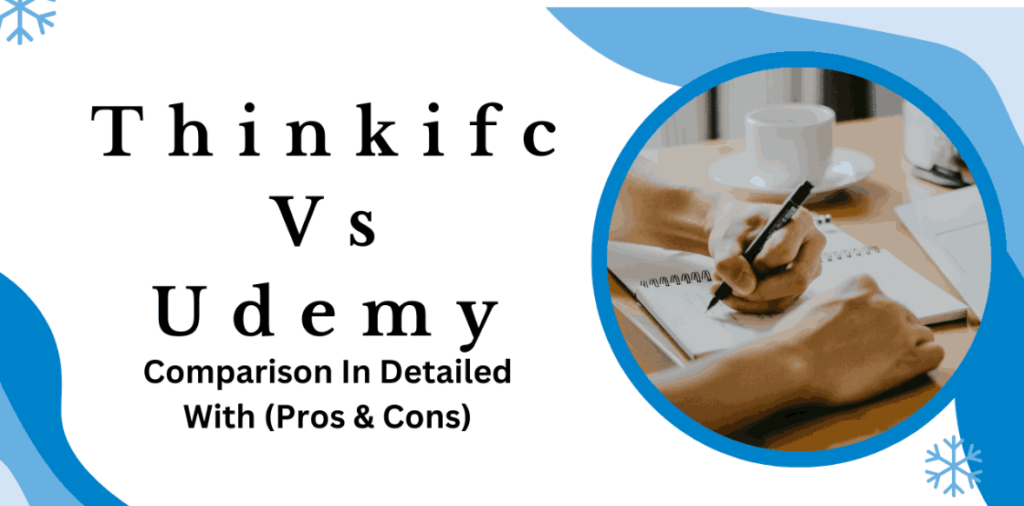
What Are Thinkific and Udemy?
Before we compare them, let’s understand what each platform does.
Thinkific
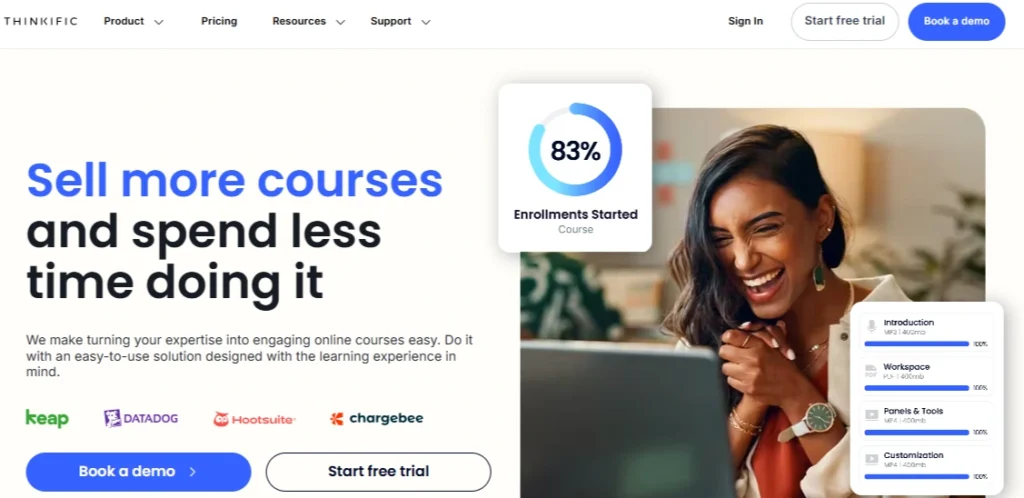
Thinkific is a tool that lets you build, market, and sell your online courses. It’s like having your own website for teaching. You get to control everything—how your course looks, how much it costs, and who your students are.
It’s perfect for people who want to create a brand and run their own teaching business.
Udemy
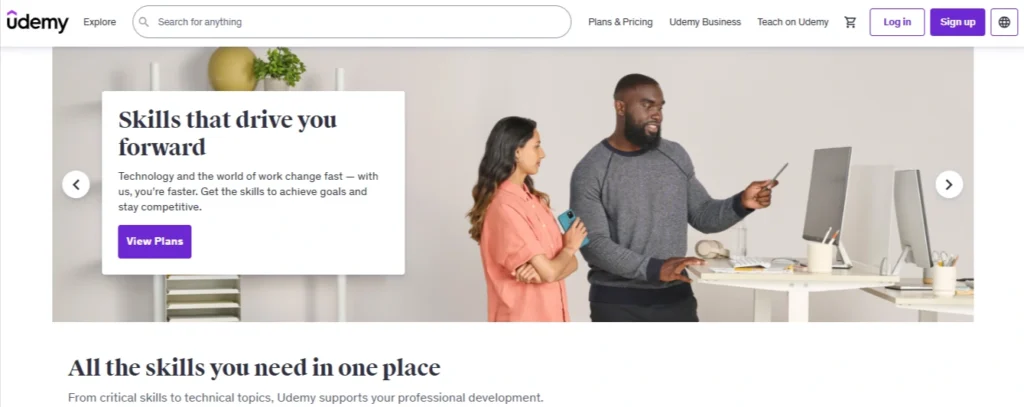
Udemy, on the other hand, is a big online marketplace. It’s like a giant store where thousands of instructors sell their courses and millions of students come to buy them.
You upload your course to Udemy, and they help you find students—but you don’t get as much control over things like pricing or branding.
In short, Thinkific is about building your own space, while Udemy is about joining a busy marketplace. Now, let’s look at how they work and what they offer.
Features: What Can You Do with Thinkific and Udemy?
Both platforms help you create courses, but they offer different tools. Here’s a breakdown of their key features.
Thinkific Features
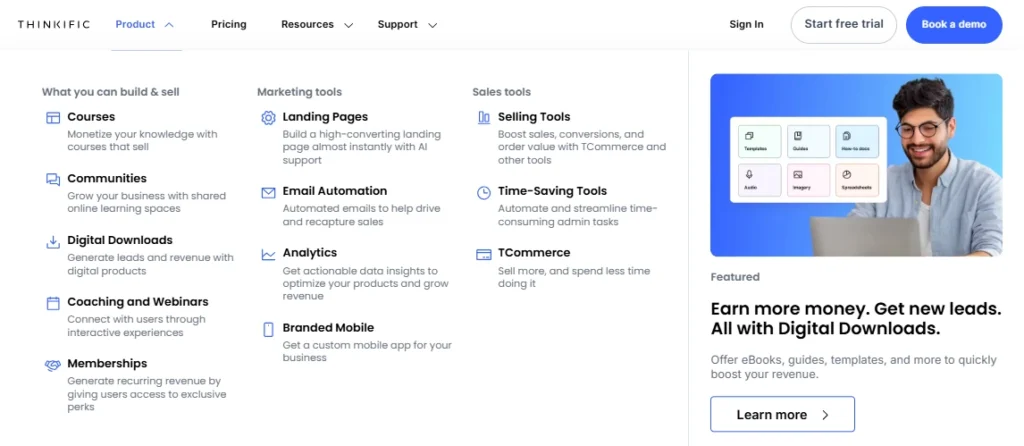
- Course Creation Tools: Thinkific has an easy drag-and-drop builder. You can add videos, quizzes, text, and files to your course without any tech skills.
- Customization: You can make your course look unique with your colors, logo, and design. It even lets you use your website name (like www.yourcourse.com).
- Student Management: You own your student data—like their emails—and can contact them directly.
- Marketing Options: Thinkific gives you tools to sell your course, like discount codes, email campaigns, and payment plans.
- Extras: You can offer live lessons, build a community space, or sell other products like eBooks alongside your course.
Udemy Features
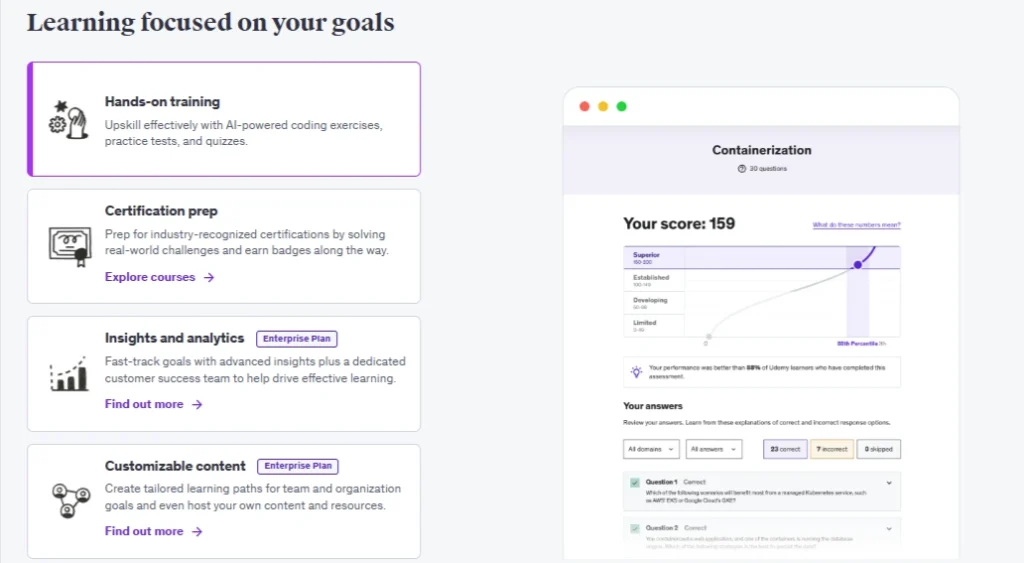
- Simple Course Builder: Udemy’s tool is basic but easy. You upload videos, add quizzes, and write descriptions—no fancy tech needed.
- Marketplace Access: Your course goes into Udemy’s huge library, where millions of students can find it.
- Certificates: Upon completing your course, students receive a certificate that they can include on their resumes.
- Basic Marketing: You can create coupons or share links, but Udemy mostly handles promotion for you.
- Video Focus: Udemy loves video courses, so it’s great if you’re making lessons with lots of recordings.
Thinkific gives you more control and tools to build something personal. Udemy keeps it simple and uses its big audience to help you reach people. Which sounds better to you so far?
Thinkific vs Udemy: Pros & Cons
Thinkific
Pros
- Full Control: You decide everything—price, design, and how your course works.
- Your Brand: It feels like your school, not someone else’s, with your logo and style.
- Keep All Profits: Thinkific doesn’t take a cut of your sales; you pay a flat fee instead.
- Flexible Pricing: Sell your course for any amount, offer subscriptions, or even give it away for free.
- Grow Your Business: Tools like email marketing and student data help you build a loyal audience.
Cons
- Costs Money Upfront: You pay a monthly fee, even if you don’t sell anything.
- No Built-In Audience: You have to find students yourself, which takes effort.
Udemy
Pros
- Huge Audience: Millions of students are already on Udemy, ready to buy courses.
- Easy Start: No need to build a website—just upload your course and go.
- Free to join: You don’t pay to start; Udemy only takes a share when you sell.
- Less Marketing Work: Udemy promotes your course, so you don’t have to do it all.
- Quick Setup: It’s fast to create a course and get it live for students.
Cons
- Low Control: You can’t set your own price freely, and Udemy takes a big cut (up to 63%).
- Less Branding: Your course looks like part of Udemy, not your own creation.
Pricing: How Much Do They Cost?
Money is a big factor when picking a platform. Let’s break down the costs.
Thinkific Pricing
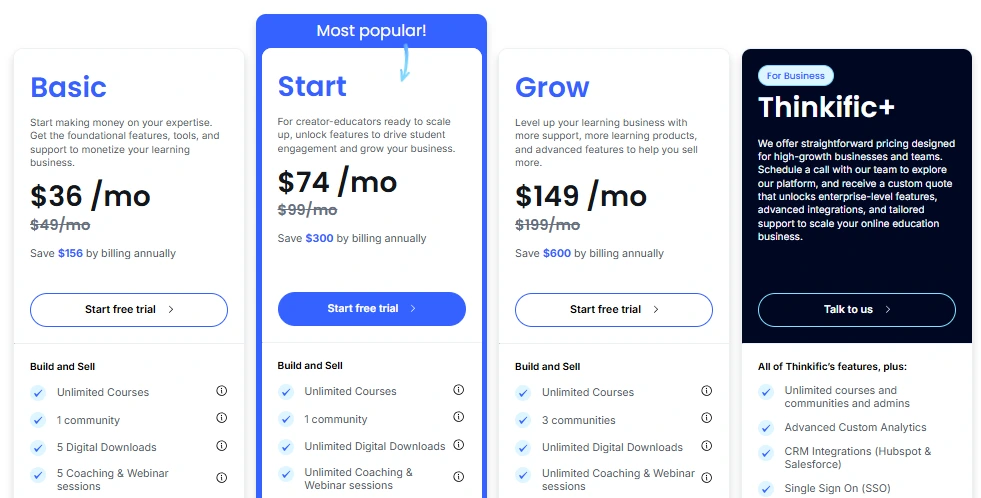
Thinkific offers flexible pricing plans for course creators and businesses. Here’s a quick breakdown:
1. Basic Plan (For beginners)
- $49/month or $36/month (billed annually, save $156)
- Unlimited courses, one community, five digital downloads, five coaching/webinar sessions
- Marketing & sales tools (coupons, email automation, affiliate selling)
- AI-powered landing pages, website builder, abandoned cart recovery
2. Start Plan (For growing creators)
- $99/month or $74/month (billed annually, save $300)
- Everything in Basic + unlimited digital downloads & coaching/webinars
- Live lessons, memberships, bundles & add-ons, advanced website editing
- More sales tools, flexible payment options
3. Grow Plan (For scaling businesses)
- $199/month or $149/month (billed annually, save $600)
- Everything in Start + 3 communities, Thinkific Analytics, group orders
- Remove Thinkific branding, enhance student engagement
4. Thinkific Plus (Enterprise Plan)
- Custom pricing (Talk to sales)
- Unlimited courses, communities, and admins
- Advanced analytics, CRM integrations, Single Sign-On (SSO)
- Dedicated customer support, branded mobile apps, SCORM compliance
💡 All plans include 0% transaction fees and a free trial!
Udemy Pricing
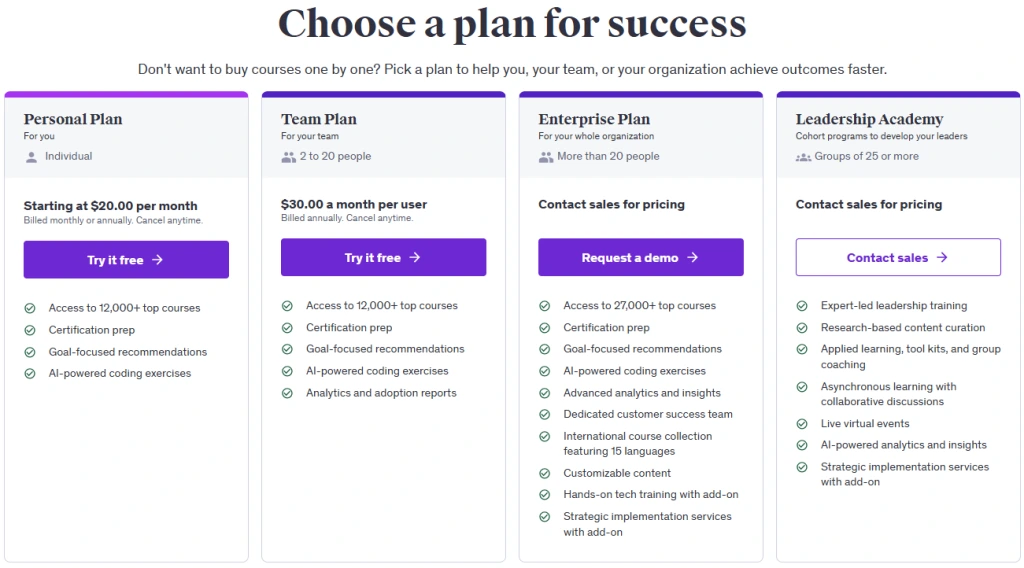
Udemy has different pricing options depending on whether you’re an individual learner or a business. Here’s a simple breakdown:
For Individual Learners
- Single Course Purchase:
- Prices range from $12.99 to $199.99 per course.
- Udemy often has discounts, so courses are available at lower prices during sales.
- Once you buy a course, you get lifetime access to it.
- Udemy Personal Plan:
- Costs $20 per month and gives access to 11,000+ courses.
- Offers a 7-day free trial for new users.
For Businesses (Udemy Business Plans)
- Team Plan (for small teams, 2-20 people):
- Costs $30 per user per month (billed yearly).
- Includes 12,000+ courses, practice tests, AI-powered coding exercises, and progress reports.
- Enterprise Plan (for larger companies):
- Custom pricing based on company needs.
- Includes everything in the Team Plan plus 28,000+ courses, advanced analytics, and dedicated customer support.
Who Are They Best For?
Not everyone wants the same thing from a course platform. Here’s who Thinkific and Udemy work best for.
Thinkific: Best For
- Entrepreneurs: People who want to build a teaching business with their own brand.
- Experts with an Audience: If you have followers (like on a blog or social media), you can sell to them directly.
- Long-Term Goals: Ideal for those planning to expand and add more courses over time.
- Creative Minds: Ideal for those who love designing unique course experiences.
Udemy: Best For
- Beginners: New teachers who don’t have an audience yet and want a fast start.
- One-Off Courses: Ideal for creating a single course without the hassle of marketing.
- Busy People: Ideal for those who lack the time to build a website or find students.
- Video Teachers: This works well if your course is mostly video-based.
Thinkific is for builders who want control. Udemy is for starters who want ease. Where do you see yourself?
How Easy Are They to Use?
Both platforms aim to be simple, but they feel different in practice.
Thinkific Usability
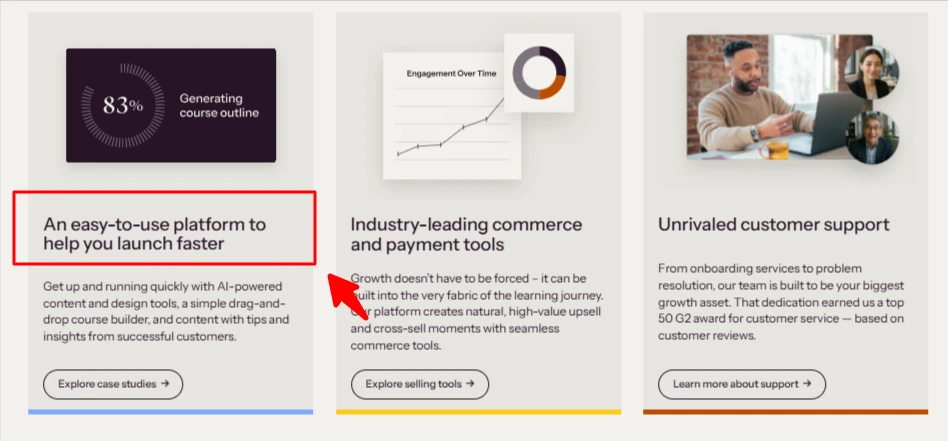
Thinkific is user-friendly, especially if you like customizing things. The drag-and-drop builder is easy to learn—you just pick what you want (videos, quizzes, etc.) and arrange it.
Setting up your site takes a bit more time because you’re designing your own space, but there’s lots of help, like tutorials and support chats. If you’re okay with a little setup, it’s smooth sailing.
Udemy Usability
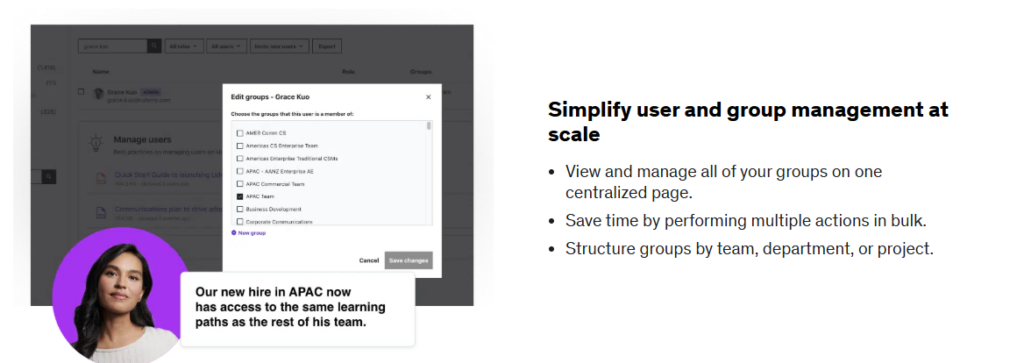
Udemy is super straightforward. You sign up, upload your videos, add a title and description, and you’re done. There’s not much to customize, so it’s fast to get started.
The downside? You don’t get to tweak much, and it can feel repetitive if you make lots of courses. But for beginners, it’s hard to beat how simple it is.
Thinkific takes more effort but gives you more options. Udemy is quick and basic. Which style do you prefer?
Marketing and Selling Your Course
Getting students is key to success. Let’s see how each platform helps with that.
Thinkific Marketing
Thinkific puts marketing in your hands. You can:
- Send emails to students.
- Offer discounts or free trials.
- Use of tools such as Google Analytics to monitor website visitors
- Connect with payment systems like Stripe or PayPal.
You have to find your students (like through social media or a blog), but you keep full control and all the money.
Udemy Marketing
Udemy does most of the work for you. They:
- Put your course in their marketplace.
- Run ads to attract students.
- Let you make coupons to share.
The catch? You compete with thousands of other courses, and Udemy takes a big share of the sales they bring in. It’s less work, but less profit too.
Thinkific is for individuals who enjoy self-promotion. Udemy is for those who want to help reach people. What’s your plan to find students?
Student Experience: What Do Learners Get?
Your students’ experience matters—they need to enjoy your course to finish it and tell others.
Thinkific Student Experience
With Thinkific, students get a polished, personal experience. They log into your custom site, watch lessons, take quizzes, and join discussions if you set them up. You can make it fun with videos, downloads, or live calls. It feels like a private classroom, which students love if they want something special.
Udemy Student Experience
Udemy keeps it simple. Students buy your course, watch videos, take quizzes, and get a certificate. It’s clean and familiar, but it’s the same for every course on Udemy. There’s not much room to stand out or add extras like live sessions.
Thinkific lets you create a unique vibe. Udemy offers a standard, no-frills setup. Which do you think your students would like more?
Support: Who Helps You When You’re Stuck?
Good support can save you when things go wrong. Here’s what each offers.
Thinkific Support
Thinkific has:
- 24/7 email and chat help (on paid plans).
- Tons of guides and videos.
- A community of other teachers to ask.
They’re quick to respond, and you feel supported as you build your course.
Udemy Support
Udemy offers:
- A help center with articles.
- Email support if you’re a premium instructor.
- No live chat or phone help.
It’s basic, and you might wait longer for answers, especially if you’re new.
Thinkific wins on support—it’s more hands-on. Udemy is fine but less personal. How much help do you think you’ll need?
Final Comparison: Thinkific vs Udemy Side by Side
Here’s a quick table to sum it up:
| Feature | Thinkific | Udemy |
|---|---|---|
| Control | Full control over everything | Limited control |
| Cost | $36/month | $20/month |
| Audience | You find your own students | Built-in marketplace |
| Customization | Lots of design options | Very little customization |
| Profit | Keep 100% of sales | 37%-97% after Udemy’s cut |
| Best For | Brand builders, entrepreneurs | Beginners, quick starters |
Which Should You Choose?
So, Thinkific or Udemy? It depends on you.
- Pick Thinkific if: You want to build your own teaching business, have some audience already (or a plan to get one), and don’t mind paying upfront for control and freedom. It’s great for long-term growth.
- Pick Udemy if: You’re new to teaching, want a big audience without much effort, and don’t care about branding or keeping all the profits. It’s perfect for a fast, easy start.
If you’re still unsure, try Thinkific’s free plan or upload a small course to Udemy to test it out. Both are great in their own way—it’s about what you need.
What’s the difference between Thinkific and Udemy for course creators?
Thinkific gives you full control over pricing, branding, and student data, while Udemy hosts your course in their marketplace and manages marketing and pricing.
Which platform is better for selling online courses—Thinkific or Udemy?
If you want to build your own brand and keep most of the revenue, Thinkific is better. Udemy is great if you prefer a done-for-you marketplace.
Does Thinkific or Udemy offer better course marketing tools?
Udemy handles most of the marketing but takes a bigger cut. Thinkific lets you create custom sales pages and integrate with your own marketing tools.
Can I use both Thinkific and Udemy to sell courses?
Yes! Many creators use Udemy to gain visibility and Thinkific to offer premium or niche content on their own branded site.
Quick Links:
- How To Create An Online Course For Free
- Pluralsight vs Udemy
- Best Pluralsight Alternatives For Learners
Conclusion: Start Your Teaching Journey
Thinkific and Udemy are both amazing tools for sharing your knowledge. Thinkific gives you the keys to your teaching kingdom, while Udemy opens the door to a crowded marketplace. Whether you want to build something personal or jump into a ready-made system, you’ve got options.
What’s your next step? Think about your goals—do you want freedom or simplicity? Then, pick a platform and start creating. The world’s waiting to learn from you!


